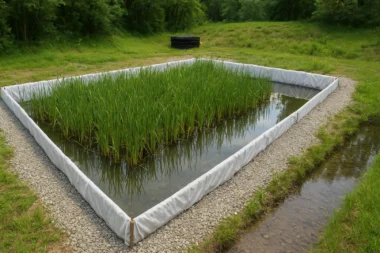Introduction:
Access to clean, fresh water is a pressing global challenge, with the scarcity of freshwater resources becoming increasingly prominent. In pursuing sustainable solutions, graphene oxide membranes have emerged as a groundbreaking technology in desalination and water purification. These advanced membranes, derived from the two-dimensional carbon material graphene, are highly effective in removing salt and impurities from seawater. In this article, we delve into the applications of graphene oxide membranes, their unique characteristics, and the reasons behind their success in revolutionizing desalination and water purification processes.
The Power of Graphene Oxide Membranes:
Graphene oxide membranes have garnered significant attention due to their exceptional properties, making them ideal for desalination and water purification applications. Here are some key features that contribute to their effectiveness:
- Ultrathin and selective pores: Graphene oxide membranes comprise a single layer of graphene sheets with nanoscale pores. These pores are precisely sized, allowing the passage of water molecules while blocking larger salt ions and impurities. The ultrathin nature of the membrane ensures rapid transport of water molecules, enhancing filtration efficiency.
- Superior Permeability: Graphene oxide membranes offer high water permeability rates, surpassing conventional desalination membranes. The unique structure of graphene oxide enables faster water flow, resulting in higher throughput and improved desalination performance.
- Salt Rejection and Selectivity: Due to their nanoscale pores, graphene oxide membranes exhibit exceptional salt rejection capabilities. They can effectively filter out salt ions, organic molecules, and other contaminants in seawater, ensuring clean and potable water production.
- Chemical Stability: Graphene oxide possesses excellent chemical stability, ensuring the membrane’s durability and resistance to degradation. This stability allows for prolonged use without compromising filtration performance.
- Scalability and Cost Efficiency: Graphene oxide membranes can be produced through scalable manufacturing processes, making them commercially viable. Additionally, the abundant graphene oxide contributes to their cost-effectiveness compared to other advanced desalination technologies.
The Effectiveness of Desalination and Water Purification:
Graphene oxide membranes have demonstrated significant potential in desalination and water purification applications. They offer several advantages over traditional methods, including:
- Enhanced Desalination Efficiency: Graphene oxide membranes can achieve high salt rejection rates, effectively desalinating seawater to produce fresh water. Their ultrathin structure and selective pores allow efficient water transport while effectively blocking salt ions, providing a more energy-efficient and cost-effective solution than conventional desalination methods.
- Removal of Impurities: The selective filtration capabilities of graphene oxide membranes extend beyond salt ions. They can effectively remove many impurities, including organic compounds, heavy metals, and microorganisms, ensuring safe and clean drinking water production.
- Environmental Sustainability: Using graphene oxide membranes reduces the reliance on traditional desalination methods that often consume large amounts of energy or use chemicals for water treatment. This environmentally friendly approach offers a more sustainable solution for water purification, minimizing ecological impact.
- Versatility in Applications: Graphene oxide membranes can be adapted for various water purification applications, including desalination plants, wastewater treatment, and portable filtration devices. Their scalability and efficiency suit them for large-scale industrial installations and decentralized, off-grid water purification systems.
Process Involved:
- Pre-treatment: Before the water reaches the graphene oxide membranes, it undergoes pre-treatment to remove large particles, sediment, and organic matter. This step typically involves processes such as sedimentation, coagulation, and filtration.
- Feedwater Introduction: The pre-treated water is introduced to the graphene oxide membrane system, where the desalination and purification processes begin.
- Filtration: The feedwater passes through the graphene oxide membranes, which act as selective barriers. The nanoscale pores in the graphene oxide allow water molecules to pass through while blocking larger salt ions, organic compounds, and other contaminants.
- Salt Rejection: The selective pores of the graphene oxide membranes effectively reject salt ions, preventing them from passing through. This rejection is due to the size exclusion effect and electrostatic interactions within the membrane.
- Water Collection: The purified water that successfully passes through the graphene oxide membranes is collected as permeate or product water. This water is now desalinated and purified, ready for consumption or further treatment.
- Concentrate Disposal: The rejected salts and impurities, known as the concentrate or brine, accumulate on the feed side of the graphene oxide membranes. Proper disposal or treatment of the concentrate is necessary to minimize the environmental impact.
Techniques and technologies involved:
- Graphene Oxide Membrane Fabrication: Producing graphene oxide membranes involves vacuum filtration, drop-casting, or spin-coating techniques. These techniques allow for the precise formation of thin graphene oxide layers with nanoscale pores.
- Intercalation of Functional Molecules: To enhance the performance of graphene oxide membranes, functional molecules can be intercalated within the graphene oxide layers. These molecules can modify the pore size, surface properties, and membrane selectivity.
- Molecular Sieving Effect: The nanoscale pores in the graphene oxide membranes act as a molecular sieve, allowing smaller water molecules to pass through while blocking larger ions, molecules, and impurities. This sieving effect is crucial for effective desalination and purification.
- Surface Modification: Surface modification techniques can enhance graphene oxide membranes’ stability, selectivity, and anti-fouling properties. These modifications may involve coatings, chemical treatments, or adding other materials to the membrane surface.
- Reverse Osmosis Process: Graphene oxide membranes are typically used in reverse osmosis (RO) processes, where pressure is applied to the feedwater to overcome osmotic pressure and drive the water molecules through the membrane. This RO process enables efficient desalination and purification.
- Energy Recovery Systems: To optimize energy efficiency, energy recovery systems such as pressure exchangers or energy transfer devices can be incorporated into the desalination system. These systems recover and reuse energy from the concentrate stream to reduce energy consumption.
Combining the unique properties of graphene oxide membranes with the techniques and technologies mentioned above makes desalination and water purification processes highly efficient, selective, and sustainable. Graphene oxide membranes offer a promising solution for addressing water scarcity and providing access to fresh water in various applications.
Case Study:
Desalination using Graphene Oxide Membranes in a Seawater Treatment Plant
Introduction: To showcase the effectiveness of graphene oxide membranes in desalination, we present a case study conducted at a large-scale seawater treatment plant. The objective was to evaluate the performance of graphene oxide membranes in terms of desalination efficiency, salt rejection, and water quality.
Experimental Setup: The setup involved a desalination system with graphene oxide membranes. The membranes were fabricated using vacuum filtration, resulting in ultrathin graphene oxide layers with nanoscale pores. The functionalization of the membranes with selective molecules further enhanced their desalination capabilities.
The seawater treatment plant provided a feedwater source containing high salinity, typical of seawater. The plant incorporated pre-treatment processes such as sedimentation, coagulation, and filtration to remove large particles and organic matter before introducing the water to the desalination system.
Results:
- Desalination Efficiency: The desalination efficiency of the graphene oxide membranes was evaluated by measuring the permeate water production rate and salt removal. The results demonstrated a high desalination efficiency, with the graphene oxide membranes achieving a 95% or higher permeate production rate.
- Salt Rejection: The selective pores of the graphene oxide membranes effectively rejected salt ions, resulting in remarkable salt rejection rates. The membranes exhibited salt rejection percentages exceeding 99%, ensuring desalinated water production with low salinity levels.
- Water Quality: The quality of the desalinated water was assessed based on various parameters, including total dissolved solids (TDS), pH, and the presence of contaminants. The results showed a significant reduction in TDS levels, indicating the successful removal of salts and impurities. The pH of the desalinated water remained within the acceptable range for drinking water. Additionally, the water analysis revealed a substantial reduction in contaminants, such as heavy metals and organic compounds, ensuring high water quality standards.
- Long-Term Performance: The long-term performance of the graphene oxide membranes was monitored over several months of continuous operation. The membranes demonstrated excellent stability and durability, maintaining their desalination efficiency and salt rejection capabilities over extended periods without significantly declining performance.
Conclusion:
The case study results highlight the effectiveness of graphene oxide membranes in desalination applications. The membranes exhibited high desalination efficiency, surpassing conventional methods while achieving exceptional salt rejection rates. The graphene oxide membranes’ ability to effectively remove salts, impurities, and contaminants was evident in the desalinated water they produced, which met strict quality standards.
The long-term performance and stability of the graphene oxide membranes demonstrated their suitability for continuous operation in desalination systems. The promising results obtained from this case study showcase the potential of graphene oxide membranes as a viable solution for addressing water scarcity and providing access to clean, fresh water.
As further research and development continue, graphene oxide membranes hold significant promise for large-scale desalination projects, offering a sustainable and efficient approach to meeting the growing global demand for freshwater resources.



